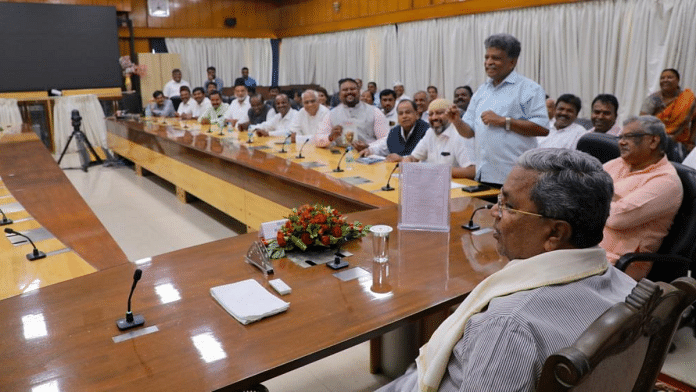Bengaluru: The Siddaramaiah-led Congress government in Karnataka has decided to receive the report of a socio-economic caste survey done by the Permanent Backward Classes Commission in 2015, a move that could potentially trigger a political firestorm.
Leaked reports of the survey had previously suggested that the population of politically dominant Vokkaligas and Lingayats is much lower than what’s commonly believed and it’s the Dalits who form the biggest demographic block. The acceptance of the survey report, gathering dust for eight years, may not go down well with these two dominant communities.
On Wednesday, Siddaramaiah assured a delegation of Karnataka Shoshitha Vargagala Maha Okkuta that he would receive the 2015 survey report and various communities will be given facilities, based on that data, according to an official press release.
“The caste-wise survey will provide the necessary data for taking appropriate decisions about the facilities to be provided to the people (preferential treatment).The survey was conducted to avail Scientific and accurate information which is essential for providing reservation and other facilities,” Siddaramaiah was quoted saying in the statement.
He added that the report would be received and appropriate action would be taken on the same.
The CM also said that he will resolve the ‘confusion’ created by the Bharatiya Janata Party (BJP) in its response to reservation-related demands by the two dominant communities. “The confusion created by (the) BJP government in reservation will be resolved. Otherwise social justice cannot be provided to anyone,” Siddaramaiah said.
In March, the then Basavaraj Bommai-led BJP government had carved out two new reservation categories (2C&2D) to placate the Vokkaligas and Lingayats and thereby removed the Muslims, earlier in 2B category, completely out of the quota list.
It had carried out the move in the hope that Lingayats will continue to back the party and it can make an outreach to the Vokkaligas, who are found in significant numbers in southern Karnataka.
The Congress had actively campaigned that the BJP ‘humiliated’ the Lingayat community by forcing B.S. Yediyurappa to step down in July 2021 and later denying tickets to Jagadish Shettar and Laxman Savadi.
Subsequently, the Congress won 135 out of the 224 seats in the Karnataka election and reduced the BJP to just 66.
Also Read: Siddaramaiah govt’s free power plan could ‘cost Rs 12,000 crore/year, increase consumption’
Pandora’s box
Conducted by the Backward Classes Commission in 2015, the socio-economic and educational survey cost the state around Rs 160 crore as 160,000 people were engaged over 45 days to cover 13.5 million households. The questionnaire posed 55 questions to determine the number of castes, composition, reservation status and benefits received, social, political and economic standing among others.
Siddaramaiah himself is from the backward Kuruba community and has for long challenged the ‘dominant caste theory’ in Karnataka which hints at the stranglehold the Lingayats and Vokkaligas have over all aspects of society.
In 2013, the Congress veteran was able to mobilise AHINDA (Kannada acronym for minorities, backward classes and Dalits) to storm to power for the first time. Lingayats and Vokkaligas have a strong grip of the state’s political and social life, and the two communities have threatened agitations if the caste census is released.
Congress legislators from these two communities have not sided with Siddaramaiah on the release of the caste census after leaked data from the unreleased report indicated a sharp change in caste population.
The government has denied the authenticity of the leaked numbers, which estimate Lingayat population below 10 percent from the estimated 17-18 percent, and around 8 percent instead of the estimated 14 percent in the case of Vokkaligas.
If the findings are established, the Dalits would be the single biggest caste group at around 24 percent. Nearly 55 per cent of Karnataka’s population is from the backward classes, according to the state backward classes welfare department.
A former government official, directly related to the caste census, said that dominant communities arrived at the number by adding 2.2 percent to the estimates every 10 years which has denied benefits to more deprived communities.
While there were 1,361 caste groups in Karnataka before the survey began, the numbers were expected to see a spike as there are many sub-castes and groupings which have officially entered the backward classes list since then.
(Edited by Tony Rai)



